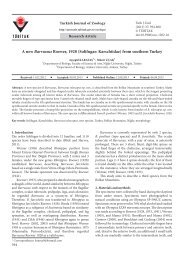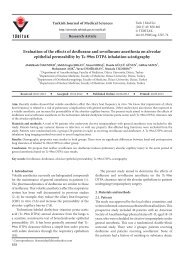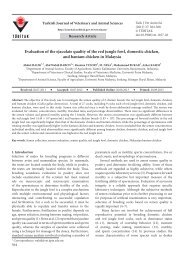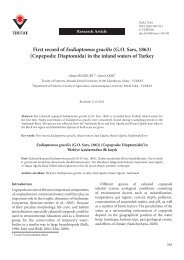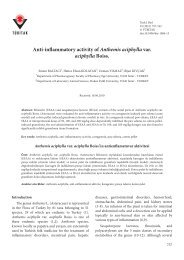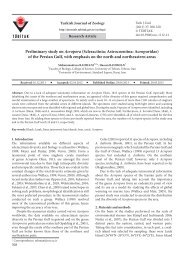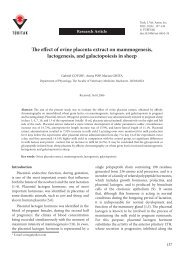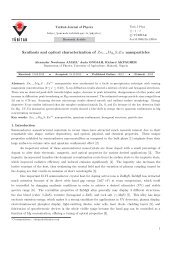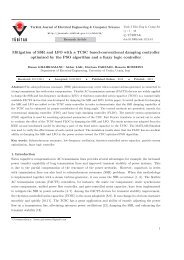An anatomical and histochemical examination of the ... - Tübitak
An anatomical and histochemical examination of the ... - Tübitak
An anatomical and histochemical examination of the ... - Tübitak
You also want an ePaper? Increase the reach of your titles
YUMPU automatically turns print PDFs into web optimized ePapers that Google loves.
Turkish Journal <strong>of</strong> Veterinary <strong>and</strong> <strong>An</strong>imal Sciences<br />
http://journals.tubitak.gov.tr/veterinary/<br />
Research Article<br />
Turk J Vet <strong>An</strong>im Sci<br />
(2013) 37: 399-403<br />
© TÜBİTAK<br />
doi:10.3906/vet-1108-21<br />
<strong>An</strong> <strong>anatomical</strong> <strong>and</strong> <strong>histochemical</strong> <strong>examination</strong> <strong>of</strong> <strong>the</strong> pituitary gl<strong>and</strong> <strong>of</strong> carp (Cyprinus carpio)<br />
Aygül EKİCİ*, Metin TİMUR<br />
Department <strong>of</strong> Aquaculture, Faculty <strong>of</strong> Fisheries, İstanbul University, Laleli, İstanbul, Turkey<br />
Received: 24.08.2011 Accepted: 26.12.2012 Published Online: 29.07.2013 Printed: 26.08.2013<br />
Abstract: The present study was carried out for <strong>the</strong> purpose <strong>of</strong> studying <strong>the</strong> <strong>anatomical</strong> <strong>and</strong> <strong>the</strong> <strong>histochemical</strong> structure <strong>of</strong> <strong>the</strong> pituitary<br />
gl<strong>and</strong> <strong>of</strong> <strong>the</strong> common carp, Cyprinus carpio. <strong>An</strong>atomically, <strong>the</strong> shape <strong>of</strong> <strong>the</strong> gl<strong>and</strong> has been observed to be round-oval, looking like an<br />
acorn. The pituitary gl<strong>and</strong> consists <strong>of</strong> <strong>the</strong> adenohypophysis <strong>and</strong> neurohypophysis parts. Microscopically, <strong>the</strong> adenohypophysis consists<br />
<strong>of</strong> anterior (pars distalis) <strong>and</strong> posterior (pars intermedia) parts. The second lobe <strong>of</strong> <strong>the</strong> gl<strong>and</strong>, called <strong>the</strong> neurohypophysis, is found in<br />
<strong>the</strong> core <strong>of</strong> <strong>the</strong> gl<strong>and</strong>. Histologically, acidophilic prolactin cells stained red or orange <strong>and</strong> were dispersed in <strong>the</strong> rostral pars distalis (proadenohypophysis)<br />
<strong>of</strong> <strong>the</strong> adenohypophysis. Basophilic thyrotropin cells stained blue <strong>and</strong> were found in a small number in <strong>the</strong> same<br />
region. Adrenocorticotropin cells showed a chromophobic character; <strong>the</strong>refore, <strong>the</strong>y did not get stained by <strong>the</strong> periodic acid-Schiff<br />
staining techniques. Gonadotropin cells were observed in <strong>the</strong> proximal pars distalis (meso-adenohypophysis) <strong>of</strong> <strong>the</strong> adenohypophysis.<br />
In <strong>the</strong> examined specimens, <strong>the</strong> faintly stained, elongated or pyramidal cells in <strong>the</strong> pars intermedia <strong>of</strong> <strong>the</strong> adenohypophysis were covering<br />
<strong>the</strong> neurohypophysis region. The neurohypophysial lobe was composed <strong>of</strong> unmyelinated nerve fibers <strong>and</strong> <strong>the</strong> pituicyte cells were located<br />
among <strong>the</strong> nerve fibers. Herring bodies were seen scattered in <strong>the</strong> neurohypophysis.<br />
Key words: Cyprinus carpio, carp, adenohypophysis, neurohypophysis, pituicyte, Herring bodies<br />
1. Introduction<br />
The pituitary gl<strong>and</strong> <strong>of</strong> fish is suspended from <strong>the</strong><br />
hypothalamus. It is one <strong>of</strong> <strong>the</strong> most important endocrine<br />
organs <strong>of</strong> fish. The histology <strong>of</strong> <strong>the</strong> pituitary <strong>of</strong> teleost fish<br />
has been described by a number <strong>of</strong> authors (1–3). These<br />
descriptions do not provide details on <strong>the</strong> histophysiology<br />
<strong>and</strong> <strong>the</strong> endocrinology <strong>of</strong> this gl<strong>and</strong>.<br />
The common carp (Cyprinus carpio) is a seasonal<br />
breeding fish with definite fluctuations in reproductive<br />
function during its annual cycle. It is well known that<br />
this process is controlled by hypophyseal gonadotropin<br />
hormones, which play a decisive role in gonadal<br />
development, ovulation, <strong>and</strong> spermiation (4).<br />
In all vertebrates, <strong>the</strong> pituitary gl<strong>and</strong> or hypophysis<br />
consists <strong>of</strong> 2 parts, separable on <strong>the</strong> bases <strong>of</strong><br />
embryology, structure, <strong>and</strong> function. These parts are<br />
<strong>the</strong> neurohypophysis <strong>and</strong> <strong>the</strong> adenohypophysis (5). The<br />
function <strong>of</strong> <strong>the</strong> adenohypophysis is <strong>the</strong> syn<strong>the</strong>sis <strong>and</strong><br />
storage <strong>of</strong> several hormones. The neurohypophysis <strong>of</strong><br />
teleost fishes secretes 2 kinds <strong>of</strong> octapeptide hormones,<br />
arginine vasotocin <strong>and</strong> isotocin (3).<br />
In some studies on teleost fishes, it has been proven that<br />
prolactin-releasing hormone, thyrotrophin-stimulating<br />
hormone (TSH), <strong>and</strong> adrenocorticotropin (ACTH) are<br />
released from <strong>the</strong> adenohypophysis (6–11). In <strong>the</strong>se<br />
* Correspondence: aekici@istanbul.edu.tr<br />
studies, it has been observed that <strong>the</strong> granules <strong>of</strong> prolactin<br />
cells can be stained red by implementing Masson’s<br />
trichrome technique, but <strong>the</strong>y cannot be stained using<br />
<strong>the</strong> periodic acid-Schiff (PAS), Alcian blue, or aldehyde<br />
fuchsin techniques.<br />
The cells that release α cells, especially in marine fishes,<br />
are acidophilic cells located in <strong>the</strong> pars distalis section <strong>of</strong><br />
<strong>the</strong> pituitary gl<strong>and</strong> <strong>and</strong> <strong>the</strong>se may be inactive prolactin<br />
cells (12). These cells may become visible using <strong>the</strong> Orange<br />
G staining technique (13,14).<br />
Gonadotropes (β <strong>and</strong> α cells) in teleost fishes are<br />
usually localized in <strong>the</strong> proximal pars distalis section<br />
<strong>of</strong> <strong>the</strong> pituitary gl<strong>and</strong> (15). It has been proven that <strong>the</strong><br />
hormones released by <strong>the</strong> pituitary gl<strong>and</strong> <strong>of</strong> vimba<br />
(Vimba vimba), common carp (C. carpio), <strong>and</strong> z<strong>and</strong>er<br />
(Stizostedion lucioperca) are similar to <strong>the</strong> hormones<br />
released by mammals. In common carp, in <strong>the</strong> rostral pars<br />
distalis, which is connected to <strong>the</strong> proximal pars distalis by<br />
<strong>the</strong> connective tissue prolactin, TSH <strong>and</strong> ACTH cells, in<br />
<strong>the</strong> shape <strong>of</strong> a plate, are present in <strong>the</strong> rostral pars distalis<br />
section <strong>of</strong> <strong>the</strong> gl<strong>and</strong> (2).<br />
Studies on fish pituitary gl<strong>and</strong>s prove that many<br />
physiological functions like growth, reproduction,<br />
reproduction-related behavior, instinct for nidification,<br />
regulation <strong>of</strong> body electrolyte balance, <strong>and</strong> gonad<br />
399
EKİCİ <strong>and</strong> TİMUR / Turk J Vet <strong>An</strong>im Sci<br />
development are controlled by hormones that are released<br />
from <strong>the</strong> pituitary gl<strong>and</strong>, in <strong>the</strong> same way that it functions<br />
in mammals (16,17).<br />
In our study, <strong>the</strong> <strong>anatomical</strong> position <strong>of</strong> <strong>the</strong> pituitary<br />
gl<strong>and</strong> in <strong>the</strong> cranium <strong>and</strong> <strong>the</strong> cells <strong>of</strong> this gl<strong>and</strong> that release<br />
<strong>the</strong>se hormones were examined histologically.<br />
2. Materials <strong>and</strong> methods<br />
This study was conducted at <strong>the</strong> Sapanca Inl<strong>and</strong> Waters<br />
Research Unit <strong>of</strong> <strong>the</strong> İstanbul University Faculty <strong>of</strong><br />
Fisheries. A total <strong>of</strong> 20 common carp (C. carpio) that were<br />
3+ years old <strong>and</strong> 1400 ± 100 g in weight were used. During<br />
this study, <strong>the</strong> fish were kept in 3 PVC circular tanks with<br />
a diameter <strong>of</strong> 3 m <strong>and</strong> a height <strong>of</strong> 1.5 m at 18–20 °C. Prior<br />
to each sampling, <strong>the</strong> fish were anaes<strong>the</strong>tized with 200<br />
ppm tricaine methanesulfonate (MS222) for 5 min (18). A<br />
cranial incision was performed using a bone saw about 1<br />
cm behind <strong>the</strong> eyes. A second incision was placed parallel<br />
to <strong>and</strong> about 3 cm from <strong>the</strong> first incision. The frontal bone<br />
located between <strong>the</strong> 2 fractions was carefully removed.<br />
The cranial incision into <strong>the</strong> scalp was cut into 2<br />
equal parts in a dorsoventral direction in <strong>the</strong> course <strong>of</strong><br />
a median line from dorsal through ventral. After <strong>the</strong><br />
hypophysectomy, <strong>the</strong> pituitary gl<strong>and</strong> in <strong>the</strong> cavity <strong>of</strong> <strong>the</strong><br />
parasphenoid sella turcica was removed. White matter was<br />
collected from <strong>the</strong> nerve fibers in this area.<br />
After removal, <strong>the</strong> fresh pituitary gl<strong>and</strong>s were<br />
fixed in 10% neutral buffered formaldehyde or Bouin<br />
solution according to <strong>the</strong> <strong>histochemical</strong> method to be<br />
implemented. Fixed samples were <strong>the</strong>n processed for<br />
histopathology (19,20). Paraffin-embedded tissues were<br />
cut into sections 4–5 µm thick using a Leica RM 2125 RT<br />
manual microtome.<br />
For <strong>the</strong> histological research, <strong>the</strong> tissue samples<br />
were stained using <strong>the</strong> hematoxylin <strong>and</strong> eosin (H&E)<br />
technique. For <strong>the</strong> <strong>histochemical</strong> study, <strong>the</strong> tissue samples<br />
were stained using <strong>the</strong> PAS, Masson’s trichrome, PAS–<br />
Orange G, Heidenhain’s azan, <strong>and</strong> orange fuchsin green<br />
(OFG) staining techniques. Stained tissue sections were<br />
examined under a Nikon E-600 computerized binocular<br />
light microscope connected to a Nikon camera.<br />
3. Results<br />
3.1. <strong>An</strong>atomical results<br />
After <strong>the</strong> hypophysectomy operation, we saw loose<br />
connective tissue in <strong>the</strong> thickness <strong>of</strong> <strong>the</strong> gel covering <strong>the</strong><br />
brain. When this loose connective tissue was cleared <strong>and</strong><br />
<strong>the</strong> brain was removed, we saw that <strong>the</strong> brain is located<br />
in a specific cavity named <strong>the</strong> sella turcica over <strong>the</strong><br />
parasphenoid bone (Figure 1).<br />
In <strong>the</strong> brain tissue, which is cream-white in color, <strong>the</strong><br />
same as <strong>the</strong> pituitary gl<strong>and</strong>, macroscopically distinguishable<br />
telencephalon, optic lobes, cerebellum, <strong>and</strong> medulla<br />
oblongata sections were located. It was determined that<br />
<strong>the</strong> pituitary gl<strong>and</strong>, which has a smooth surface, is under<br />
<strong>the</strong> optic lobes <strong>of</strong> <strong>the</strong> brain, morphologically similar to an<br />
acorn or pear, <strong>and</strong> its size ranges from approximately 1 × 3<br />
mm to 2 × 3 mm (Figure 2).<br />
3.2. Histological results<br />
The adenohypophysis <strong>and</strong> neurohypophysis sections<br />
<strong>of</strong> <strong>the</strong> pituitary gl<strong>and</strong> <strong>of</strong> <strong>the</strong> common carp were easily<br />
distinguished when <strong>the</strong> samples were stained with <strong>the</strong><br />
H&E staining technique.<br />
3.2.1. Adenohypophysis<br />
Prolactin cells, ACTH cells, <strong>and</strong> TSH cells were<br />
observed in <strong>the</strong> front part <strong>of</strong> <strong>the</strong> adenohypophysis (proadenohypophysis)<br />
section <strong>of</strong> <strong>the</strong> pituitary gl<strong>and</strong>, which is<br />
formed <strong>of</strong> hormone-releasing gl<strong>and</strong>ular tissues.<br />
It was confirmed that <strong>the</strong> prolactin cells are distributed<br />
r<strong>and</strong>omly in <strong>the</strong> hypophysis <strong>of</strong> common carp while <strong>the</strong>y<br />
are in follicular distribution in salmon <strong>and</strong> eels (Figure<br />
3). It was observed that <strong>the</strong>se acidophilic cells containing<br />
secretion granules do not get stained well with PAS but<br />
none<strong>the</strong>less can be stained with Heidenhain’s azan stain.<br />
It was seen that adrenocorticotropic cells are lined<br />
up in single or double rows in such a way as to become<br />
neighbors with <strong>the</strong> neurohypophysis in <strong>the</strong> upper parts<br />
<strong>of</strong> <strong>the</strong> adenohypophysis (Figure 4). In <strong>the</strong> <strong>examination</strong> <strong>of</strong><br />
<strong>the</strong>se cells after using Heidenhain’s azan staining technique,<br />
it was observed that <strong>the</strong>y contain secreting granules.<br />
TSH cells were seen individually or in groups. These<br />
basophilic cells found in tissue samples that were stained<br />
using <strong>the</strong> PAS <strong>and</strong> Heidenhain’s azan staining techniques<br />
revealed a large number <strong>of</strong> secreting granules (Figure 5).<br />
We noted that gonadotrope (GTH) cells increase in<br />
number in common carp. It was determined that <strong>the</strong> tissues<br />
stained with PAS are basophilic in character (unpublished<br />
data) <strong>and</strong> have numerous secreting granules (Figure 6).<br />
3.2.2. Neurohypophysis<br />
In microscopic <strong>examination</strong>s <strong>of</strong> <strong>the</strong> neurohypophysis,<br />
numerous glia (pituicytes) were detected among <strong>the</strong> nerve<br />
fibers (Figure 7). Herring bodies, which are stainable<br />
secretion granules <strong>and</strong> are found in nerve fibers, were seen<br />
in large numbers in <strong>the</strong> tissue samples (Figure 8).<br />
4. Discussion<br />
The pituitary gl<strong>and</strong> in common carp, like in all vertebrates,<br />
is a master internal secretion organ controlling growth<br />
<strong>and</strong> reproduction, enabling body electrolyte balance <strong>and</strong><br />
controlling all o<strong>the</strong>r endocrine gl<strong>and</strong>s (21).<br />
In <strong>the</strong> <strong>anatomical</strong> <strong>examination</strong> made <strong>of</strong> <strong>the</strong> common<br />
carp’s cranium, it was seen that <strong>the</strong> pituitary gl<strong>and</strong> is<br />
embedded in <strong>the</strong> sella turcica cavity, which is above <strong>the</strong><br />
parasphenoid bone right beneath <strong>the</strong> brain. The gl<strong>and</strong> is<br />
400
EKİCİ <strong>and</strong> TİMUR / Turk J Vet <strong>An</strong>im Sci<br />
Figure 1. The pituitary gl<strong>and</strong> is located in <strong>the</strong> sella turcica.<br />
Figure 3. Prolactin cells in pro-adenohypophysis, PAS 100×, bar<br />
= 10 µm.<br />
Figure 2. The general appearance <strong>of</strong> <strong>the</strong> pituitary gl<strong>and</strong> is similar<br />
to an acorn or pear.<br />
similar to an acorn in shape. However, it has been stated<br />
that this gl<strong>and</strong> is in <strong>the</strong> shape <strong>of</strong> a cone in z<strong>and</strong>er <strong>and</strong><br />
sunfish, <strong>and</strong> is round in vimba (V. vimba) (2).<br />
In common carp, like in all vertebrates, it was observed<br />
that <strong>the</strong> pituitary gl<strong>and</strong> is formed <strong>of</strong> <strong>the</strong> adenohypophysis<br />
<strong>and</strong> <strong>the</strong> neurohypophysis lobes, while <strong>the</strong> adenohypophysis<br />
divides into <strong>the</strong> pars distalis <strong>and</strong> pars intermedia parts,<br />
<strong>and</strong> one <strong>of</strong> <strong>the</strong>se parts, <strong>the</strong> pars distalis, constitutes <strong>the</strong><br />
proximal <strong>and</strong> <strong>the</strong> rostral parts. It has been stated that <strong>the</strong><br />
pars tuberalis part, which is formed by <strong>the</strong> extension <strong>of</strong> <strong>the</strong><br />
adenohypophysis through <strong>the</strong> infundibular stem, does not<br />
exist in common carp (16,22–25).<br />
As in European eels (<strong>An</strong>guilla anguilla) <strong>and</strong> crucian<br />
carp (Carassius carassius), in <strong>the</strong> rostral pars distalis part<br />
<strong>of</strong> <strong>the</strong> pituitary gl<strong>and</strong> <strong>of</strong> <strong>the</strong> common carp used in our<br />
research, <strong>the</strong> presence <strong>of</strong> TSH <strong>and</strong> ACTH cells was detected<br />
Figure 4. ACTH cells in pro-adenohypophysis, H&E 100×, bar<br />
= 10 µm.<br />
(23,24). It was seen that <strong>the</strong> prolactin cells, as stated by<br />
o<strong>the</strong>r researchers, are <strong>of</strong> an acidophilic character, as <strong>the</strong>y<br />
are stained red or orange with <strong>the</strong> H&E, Heidenhain’s<br />
azan, PAS, PAS–Orange G, <strong>and</strong> OFG stains (19,20,22), <strong>and</strong><br />
<strong>the</strong>se cells are found all around except in <strong>the</strong> dorsal parts<br />
<strong>of</strong> <strong>the</strong> pars distalis in common carp.<br />
It was seen that <strong>the</strong> cells that release TSH from <strong>the</strong><br />
pituitary gl<strong>and</strong> are <strong>of</strong> basophilic character <strong>and</strong> are stained<br />
blue with <strong>the</strong> H&E, Heidenhain’s azan, PAS, PAS–Orange<br />
G, <strong>and</strong> OFG stains (1–3).<br />
It was determined that <strong>the</strong> ACTH cells, which are<br />
chromophobic <strong>and</strong> do not get stained at all, are distributed<br />
all around <strong>the</strong> pars distalis (19,24,26).<br />
Our previous experimental results showed that<br />
somatotropes, STH cells, were located in <strong>the</strong> mesoadenohypophysis<br />
part <strong>of</strong> <strong>the</strong> common carp (C. carpio)<br />
pituitary gl<strong>and</strong>, <strong>and</strong> <strong>the</strong>se cells were shown in <strong>the</strong> samples<br />
401
EKİCİ <strong>and</strong> TİMUR / Turk J Vet <strong>An</strong>im Sci<br />
Figure 5. TSH cells in pro-adenohypophysis, Heidenhain’s azan<br />
100×, bar = 10 µm.<br />
Figure 7. Pituicyte cells in neurohypophysis, Heidenhain’s azan<br />
100×, bar = 10 µm.<br />
Figure 6. GTH cells in meso-adenohypophysis, Masson’s<br />
trichrome 100×, bar = 10 µm.<br />
Figure 8. Herring bodies in neurohypophysis, OFG 100×, bar =<br />
10 µm.<br />
stained with <strong>the</strong> PAS–Orange G <strong>and</strong> H&E staining<br />
techniques. In <strong>the</strong> meta-adenohypophysis, melanocytestimulating<br />
hormone (MSH) cells were stained with PAS<br />
stain (27).<br />
Gonadotropic cells, found in <strong>the</strong> pars distalis part <strong>of</strong><br />
<strong>the</strong> pituitary gl<strong>and</strong> in teleost fishes, were observed to be<br />
basophilic in character <strong>and</strong> <strong>the</strong>y were stained dark blue<br />
with PAS, Masson’s trichrome, <strong>and</strong> Heidenhain’s azan<br />
stains (3).<br />
Like in o<strong>the</strong>r teleost fishes <strong>and</strong> tetrapods, it was<br />
determined in this research that <strong>the</strong> neurohypophysis<br />
nerve fibers <strong>and</strong> nerve cells are without myelin (pituicytes).<br />
It was observed that <strong>the</strong> stainable <strong>and</strong> <strong>the</strong> secreting granule<br />
containing a specific type (Herring bodies) <strong>of</strong> <strong>the</strong>se fibers<br />
exist in great numbers in <strong>the</strong> neurohypophysis (2,3).<br />
In conclusion, it was seen that <strong>the</strong> pituitary gl<strong>and</strong> <strong>of</strong> <strong>the</strong><br />
common carp is morphologically similar to an acorn. It was<br />
determined that, <strong>anatomical</strong>ly, this gl<strong>and</strong> is substantially<br />
similar to <strong>the</strong> pituitary gl<strong>and</strong> <strong>of</strong> o<strong>the</strong>r vertebrates. As for<br />
histology, <strong>the</strong> acidophilic, basophilic, <strong>and</strong> chromophobic<br />
cells described in vertebrates, <strong>and</strong> characterized in o<strong>the</strong>r<br />
teleost fishes, show similar <strong>histochemical</strong> reactions in<br />
common carp (5).<br />
Acknowledgments<br />
The authors would like to thank Pr<strong>of</strong> Dr Charles Allen<br />
Scarboro for helping with <strong>the</strong> English grammar. We<br />
would also like to thank Assist Pr<strong>of</strong> Erdoğan Güven <strong>and</strong><br />
<strong>the</strong> Sapanca Inl<strong>and</strong> Water Research Unit workers. This<br />
research project was supported by <strong>the</strong> İstanbul University<br />
Research Fund (Project Number: 4326).<br />
402
EKİCİ <strong>and</strong> TİMUR / Turk J Vet <strong>An</strong>im Sci<br />
References<br />
1. Balcı, B., İkiz, B.R., Mutaf, B.F.: Histomorphological comparison<br />
<strong>of</strong> pituitary gl<strong>and</strong> <strong>of</strong> dusky grouper (Epinephelus guaza L.,<br />
1758) <strong>and</strong> blacktip grouper (Epinephelus alex<strong>and</strong>rinus V.,<br />
1828). JFAS, 2006; 23: 183–186 (article in Turkish with an<br />
abstract in English).<br />
2. Özen, M.R., Timur, G.: Lighted microscopic identification<br />
<strong>of</strong> cell types in carp, pike <strong>and</strong> vimba pituitary gl<strong>and</strong> with<br />
<strong>histochemical</strong> methods. Doğa Turk. J. Biol., 1993; 17: 311–320<br />
(article in Turkish with an abstract in English).<br />
3. Hibiya, T.: <strong>An</strong> Atlas <strong>of</strong> Fish Histology. Gustow Fischer Verlag,<br />
Stuttgart. 1982.<br />
4. Breaton, B., Govoroun, M., Mikolajczyk, T.: GtH I <strong>and</strong> GTH<br />
II secretion pr<strong>of</strong>iles during <strong>the</strong> reproductive cycle in female<br />
rainbow trout. Gen. Comp. Endocrinol., 1968; 84: 264–276.<br />
5. Ross, M.H., Pawlina, W.: Histology: A Text <strong>and</strong> Atlas. 5th edn.,<br />
Lippincott Williams & Wilkins, Philadelphia. 2003; 716–719.<br />
6. Pickford, G.E., Atz, W.: The Physiology <strong>of</strong> <strong>the</strong> Pituitary Gl<strong>and</strong><br />
<strong>of</strong> Fishes. New York Zoological Society, New York. 1957.<br />
7. Follenius, E.: Ultrastructure <strong>of</strong> <strong>the</strong> cell in <strong>the</strong> pituitary gl<strong>and</strong> in<br />
teleost fish. Arch. <strong>An</strong>at. Microscop. Morphol. Exptl., 1963; 52:<br />
429–468 (in French).<br />
8. Ball, J.N, Olivereau, M., Slicher, A.M., Kallman, K.D.:<br />
Functional capacity <strong>of</strong> ectopic pituitary transplants in <strong>the</strong><br />
teleost P. formosa, with a comparative discussion on <strong>the</strong><br />
transplanted pituitary. Phil. Trans. Roy. Soc. London, 1965;<br />
249: 69–99.<br />
9. Ball, J.N., Olivereau, M.: Identification <strong>of</strong> <strong>the</strong> ACTH cells in<br />
<strong>the</strong> pituitary <strong>of</strong> two teleosts, Poecilia latipinna <strong>and</strong> <strong>An</strong>guilla<br />
anguilla; correlated changes in <strong>the</strong> internal <strong>and</strong> in <strong>the</strong> pars<br />
distalis resulting from <strong>the</strong> administration <strong>of</strong> metopirone (Su<br />
4885). Gen. Comp. Endocrinol., 1966; 6: 5–18.<br />
10. Hoar, W.S.: Hormonal activities <strong>of</strong> <strong>the</strong> pars distalis in<br />
cyclostomes, fish <strong>and</strong> amphibia. In: Harris, G.W., Donovan,<br />
B.T., Eds. The Pituitary Gl<strong>and</strong>, Vol. 1. Butterworth, London.<br />
1966; 242–294.<br />
11. Ball, J.N.: Prolactin <strong>and</strong> osmoregulation in teleost fishes. Gen.<br />
Comp. Endocrinol. Suppl., 1969; 2: 10–25.<br />
12. Olivereau, M.: The effect <strong>of</strong> radiation on <strong>the</strong> pituitary gl<strong>and</strong> <strong>of</strong><br />
eel. Gen. Comp. Endocrinol., 1963; 3: 312–332 (in French).<br />
13. Herlant, M.: Present state <strong>of</strong> knowledge concerning <strong>the</strong><br />
cytology <strong>of</strong> <strong>the</strong> anterior lobe <strong>of</strong> <strong>the</strong> hypophysis. Proc. 2nd<br />
Intern. Cong. Endocrinol., London. 1965; 468–481.<br />
14. Purves, H.D.: Cytology <strong>of</strong> <strong>the</strong> adenohypophysis. In: Harris,<br />
G.W., Donovan, B.T., Eds. The Pituitary Gl<strong>and</strong>, Vol. 1.<br />
Butterworth, London. 1966; 147–232.<br />
15. Stahl, A.: Adenohypophysis cytophysiology on fish. In: Benoit,<br />
J., DaLages, C., Eds. Adenohypophysis Cytophysiology. Paris.<br />
1963: 331-344 (in French).<br />
16. Val-Sella, M.V., Guiffrida, R.: Morphology <strong>of</strong> <strong>the</strong> carp<br />
hypophysis. <strong>An</strong>at. <strong>An</strong>z., 1977; 142: 403–409.<br />
17. Evans, D.: The Physiology <strong>of</strong> Fishes. 2nd edn., CRC Press, Boca<br />
Raton, Florida. 1998.<br />
18. Timur, G., Timur, M.: Fish Disease. İstanbul University Faculty<br />
<strong>of</strong> Fisheries, Istanbul. 2003 (in Turkish).<br />
19. Cullings, C.F.A.: H<strong>and</strong>book <strong>of</strong> Histopathological Techniques.<br />
2nd edn., Butterworth, London. 1963.<br />
20. Bancr<strong>of</strong>t, J.D., Stevens, A.: Theory <strong>and</strong> Practice <strong>of</strong> Histological<br />
Techniques. Churchill-Livingstone, Edinburgh. 1977.<br />
21. Stoskopf, M.K.: Fish histology. In: Stoskopf, M.K., Ed. Fish<br />
Medicine. W.B. Saunders Co., Philadelphia. 1993; 31–48.<br />
22. Scruggs, W.M.: The epi<strong>the</strong>lial component <strong>of</strong> <strong>the</strong> teleost<br />
pituitary gl<strong>and</strong> as identified by a st<strong>and</strong>ardized method <strong>of</strong><br />
selective staining. J. Morphol., 1939; 65: 187–213.<br />
23. Ball, J.N., Baker, J.: The pituitary gl<strong>and</strong>: anatomy <strong>and</strong><br />
histophysiology. In: Hoar, W.S., R<strong>and</strong>all, D.J., Eds. Fish<br />
Physiology, Vol. 2. Academic Press, New York. 1969; 1–270.<br />
24. Kaul, S., Vollrath, L.: The goldfish pituitary. Cell Tiss. Res. 1974;<br />
154: 211–230.<br />
25. Turner, C.D., Bagnara, J.T.: General Endocrinology. W.B.<br />
Saunders Co., Philadelphia. 1976.<br />
26. Gabe, M.: Histological Techniques. Springer, Paris. 1976; 986–<br />
1007.<br />
27. Timur, M., Ekici, A.: Microscopic <strong>examination</strong> <strong>of</strong><br />
adenohypophysis <strong>of</strong> common carp (Cyprinus carpio). İstanbul<br />
Univ. J. Fish. Aquat. Sci., 2011; 26: 1–12 (in Turkish).<br />
403



